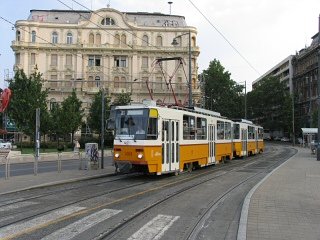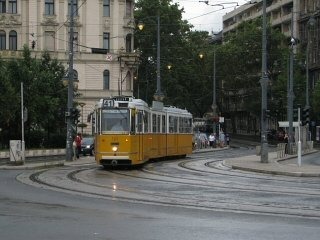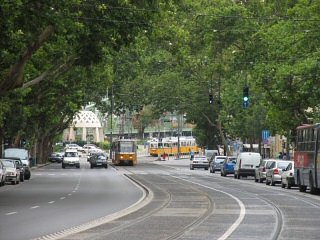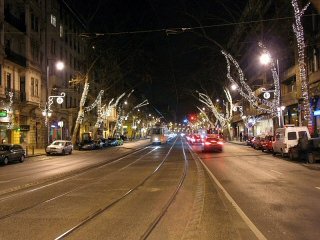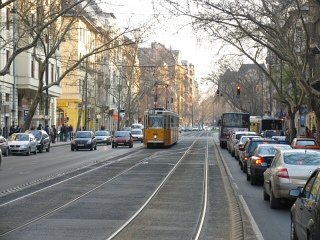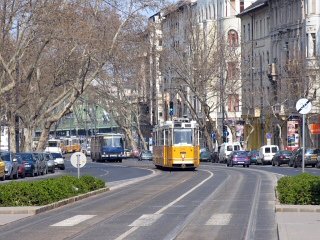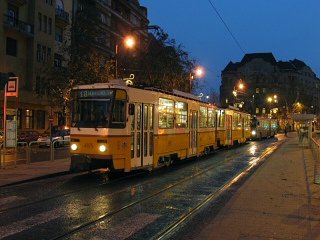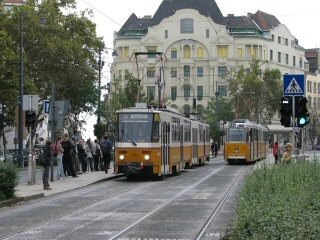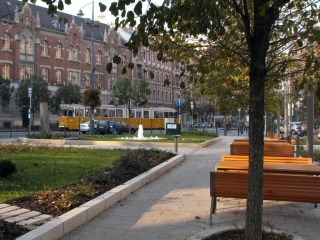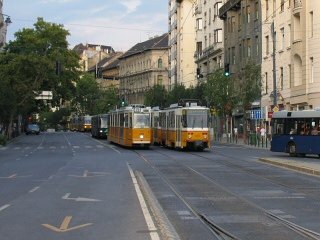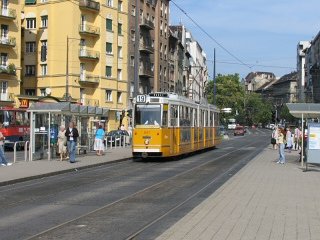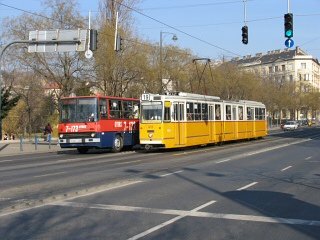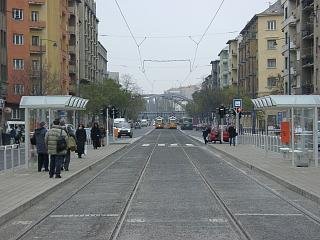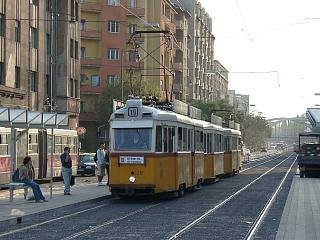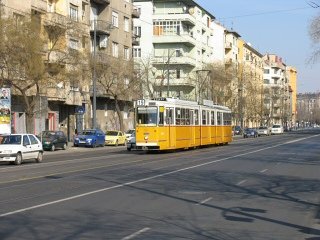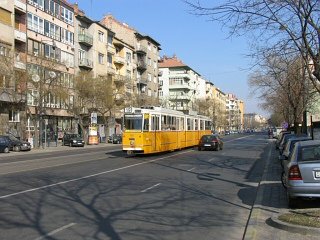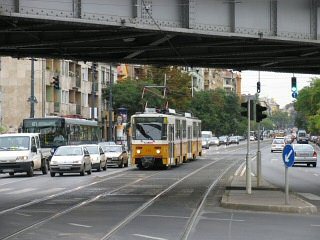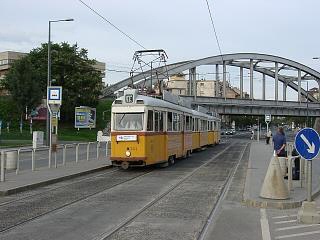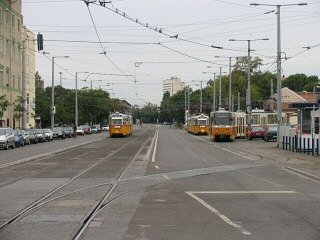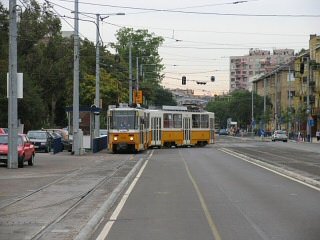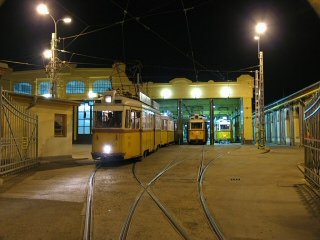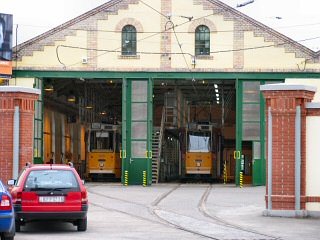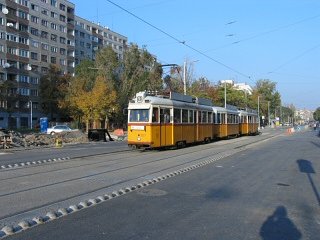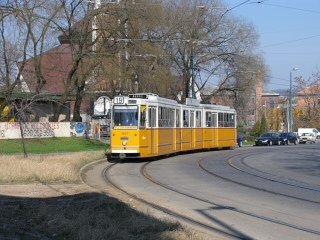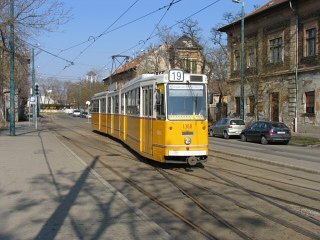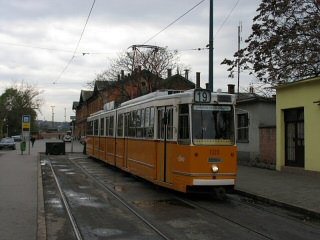Latest update: 2. July, 2016
Bartók Béla út is probably the most tram-intensive place in Budapest nowadays. Okay, the Grand Boulevard might be more packed with passengers (due to the larger vehicles), but Bartók Béla út is more colorful because of the many services (18, 19, 41, 47, 49) running there.
Update, July 2016: The tracks and stops in Bartók Béla út and Fehérvári út are being renovated from June 16 to August 22, affecting all tram services (17, 19, 41, 47, 48, 49, 56/56A) running there. Details on this map.
The first electric trams ran here in late 1898, as an extension of the Small Boulevard trunk-line over the Danube via the Szabadság híd. BKVT has even built a new remise along the line at Kelenföld, which was opened in 1899. The facility was soon turned into their main workshop on the Buda side. In the same year the company BBVV launched a vicinal service from Szent Gellért tér to Budafok - this was the predecessor of today's Fehérvári út trams. BKVT and BBVV was unable to negotiate the sharing of electric power, so the latter built out its own overhead wire over and slightly besides the tracks - its cars reached this wire with trolley poles (BKVT was using bow current collectors).
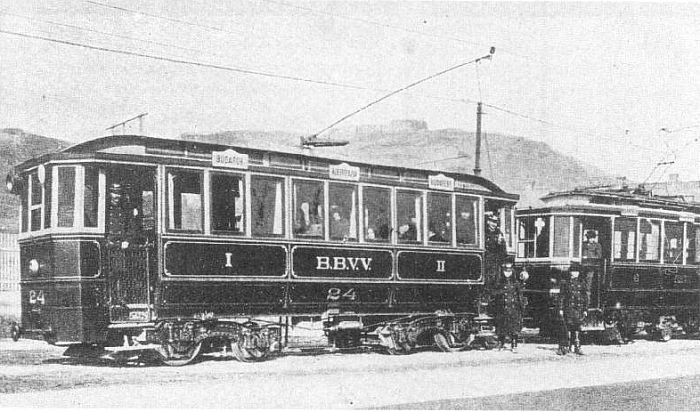
As you can see, in those days Bartók Béla út (yet called Fehérvári út and Átlós utca) was not yet built in. This soon changed, and the mansions built around the turn of the century still dominate the street which became the main street of district 11, also known as Újbuda (New Buda).
Trivia: The street was named after the famous composer/pianist/ethnomusicologist Bartók Béla.
Here's a Google Map map of the stretch:
On the pictures on this page you will see lots of UVs. These classic 4-axle tramcars were withdrawn in August 2007, but I'll use these pictures anyhow, because I think Bartók Béla út looked best with them :) On some pictures you will also notice heavy road construction works going on, these were taken during the renovations mentioned above.
![]()
Between Szent Gellért tér and Móricz Zsigmond körtér
This square is dominated on one side by the Danube and the remarkable Szabadság híd, on another by the rocks of Gellért-hegy (St. Gellert Hill), on the third by the large block of Hotel Gellért, and on the fourth by elegant mansions (photo on the right-hand side below). This means you can get nice views of trams any time of the day - on the other hand, you might need some patience due to the heavy traffic (cars, trams and people coming from every possible directions at the worst moments).
When taking photos, please make sure you don't block the way of anybody or anything!
->
Back to the Danube embankment section
-> Over to Szabadság
híd and the Small Boulevard
As trams are heading southwest, they start to climb a bit. This is the place where I came to love trams when I was a child, so I'm a bit biased, but I think the trees leaning over the street make a wonderful scenery!
The bends look great with a zoom lens, but due to the heavy vehicular traffic it's not easy to get an unhindered view of the trams with the old houses behind them.
The stop at Gárdonyi tér can be best photographed in the forenoon - or in the night, with a tripod. Other times can be tricky because of the shadows cast by the houses.
The two small bends and the slope leading towards Móricz Zsigmond körtér would make for a great photo site, but it's almost impossible to get a good view of it partly because of the shadows and partly because of the heavy car traffic.
My next photos were already taken at Móricz Zsigmond körtér. On the left-hand-side photo you can get a hint of how busy this urban transit corridor is (the buses were tram supplementing services).
->
More about Móricz Zsigmond körtér
->
Further on to Fehérvári út
Since most of the tram services turn left into Fehérvári út, the remaining section is less of a tram paradise - but still interesting!
Under "outer Bartók Béla
út" I mean the stretch outside of Kosztolányi Dezső tér. The
section between Móricz Zsigmond körtér and Kosztolányi Dezső
tér is rather narrow, and photo views are usually hindered by car traffic.
 
If you have some free time, you can relax a few minutes in the park next to the street, which also features a small lake named "Bottomless Lake". That, and the church behind it are the symbols of "New Buda". Kosztolányi Dezső tér used to be a bus-intensive place until a few years ago, but most of the bus termini (including a large one for vicinal bus services) were moved away from here. Trivia: this square was named after hungarian poet and writer Dezső Kosztolányi. |
The following section is unswerwing...
... and probably a bit boring, too :)
The next characteristic landmark is the arc bridge of the southern connecting railway, which leads the trains coming from Vienna towards Keleti pályaudvar on the Pest side. If you're coming with a train from there, chances are that you will spot your first Budapest tram from this bridge.
The section between the railway bridge and Etele tér is loosely built-in, and sports a number of ugly, communist-type highrise apartment buildings.
However, if you don't turn back by the lack of nicencess :) you'll soon arrive to the Kelenföld tram depot. This is one of the very few tram depots in the city with proper connecting tracks between the "live" tracks and the carbarn tracks, so with a bit of luck you might be able to take photos of trams running parallel here.
The remise also houses a workshop for Ganz articulated trams, so sometimes you can spot such cars coming (or being towed) here for a repair.
By the way, this remise (together with another building which has been sold long ago) once housed the Árpád Füzesi Tram Workshop, where the infamous "Bengáli" trams were originally built.
But let's continue our walk towards Etele tér!
After a few hundred meters, the street ends at the brim of Kelenföld railway station. Here the tram tracks turn south, into a small street called Vasút utca ("Railroad Street"). This used to be a housing area for lower-class railway employees, but some of the old buildings were removed recently. The whole area is planned to be rehabilitated when the M4 metro line will be complete, but I guess that's still a few years away.
The terminus: Etele tér, Kelenföldi pályaudvar
Kelenföld station is where the main railway lines of Dunántúl (Transdanubia) meet each other and enter Budapest, so it's a busy intermodal changing point for commuters. Its also the site for an interurban bus terminus, and as it seems metro line M4 will also end (start) here.
The terminus is a simple two-track stub one, with a scissors crossover. A reversing loop in front of the railway station was abandoned in the late nineties, and this terminus is therefore a bit far away from where the people are - which is soooo typical for Budapest :(
Back to the top
Back to the opening page
Back to the clickable map
Disclaimer:
The author cannot be held responsible for mistakes, misinterpretations,
inaccuracies, inactualities, etc. on/of these pages, nor for the content
of other pages linked in.
Archive photos:
from the collection of Zoltán Ádám Németh
![]()
Send
a mail to the author
The
author's homepage
